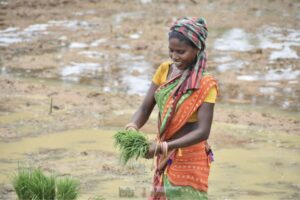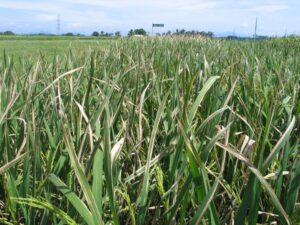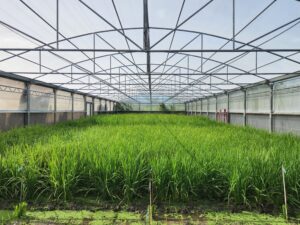Bihar, India – Union Minister of Agriculture Shri Radha Mohan Singh asked farmers from 15 states of India to grow Swarna-Sub1, among other flood-tolerant rice varieties. This was the minister’s key message during the 2015 Horticulture Conclave in Bihar on 10 April 2015.
Flood-tolerant rice is a major innovation that can greatly help bring the second green revolution to eastern India,” stated Singh.
“About 30% of rice area in India is flood prone,” said Sudhanshu Singh, an agronomist at the International Rice Research Institute (IRRI) who works on rainfed lowland rice systems. Thus, flood-tolerant rice, such as Swarna-Sub1, can help increase farmers’ incomes by enabling them to grow rice in previously unproductive areas.
In response to the call of the minister, many farmers at the event visited the IRRI booth to learn more about flood-tolerant rice. “This is the first time I learned about this variety and I cannot believe that it can survive under water for more than 12 days,” says Kishore Yadav, a farmer from Betiah district. I will grow this next season in my field near river Gandak.”
Farmers were also interested in drought-tolerant Sahbhagi dhan, as the lack of water often affects rice grown in elevated areas.
Minister Singh appreciated IRRI’s efforts in distributing brochures on the management of these stress-tolerant varieties in Hindi and other local languages. He also acknowledged IRRI’s efforts in disseminating the technology and seeds of climate-smart rice in Bihar through the Improved Rice-Based Rainfed Agricultural Systems and the Stress-Tolerant Rice for Africa and South Asia (STRASA) projects.
The government has implemented large-scale programs for the multiplication and distribution of seeds of Swarna-Sub1 and Sahbhagi dhan. These programs include the National Food Security Mission (NFSM) and Bringing the Green Revolution in Eastern India (BGREI). In Bihar, the IRRI-NFSM project has planted about 4,500 hectares of demonstration plots to climate-smart rice over the last 3 years.
In Bihar, a large quantity of Swarna-Sub1 and Sahbhagi dhan seeds were distributed in 2014. The government has invested in large-scale seed production of these varieties and is expected
to produce more than 3,000 tons of Swana-Sub1 seed this year alone.
“We will not rest until we succeed in ensuring the turnaround of the farm sector and see smiles on the faces of the farmers,” the agriculture minister said.
Learn more about IRRI (www.irri.org) or follow us on the social media and networks (all links down the right column).










